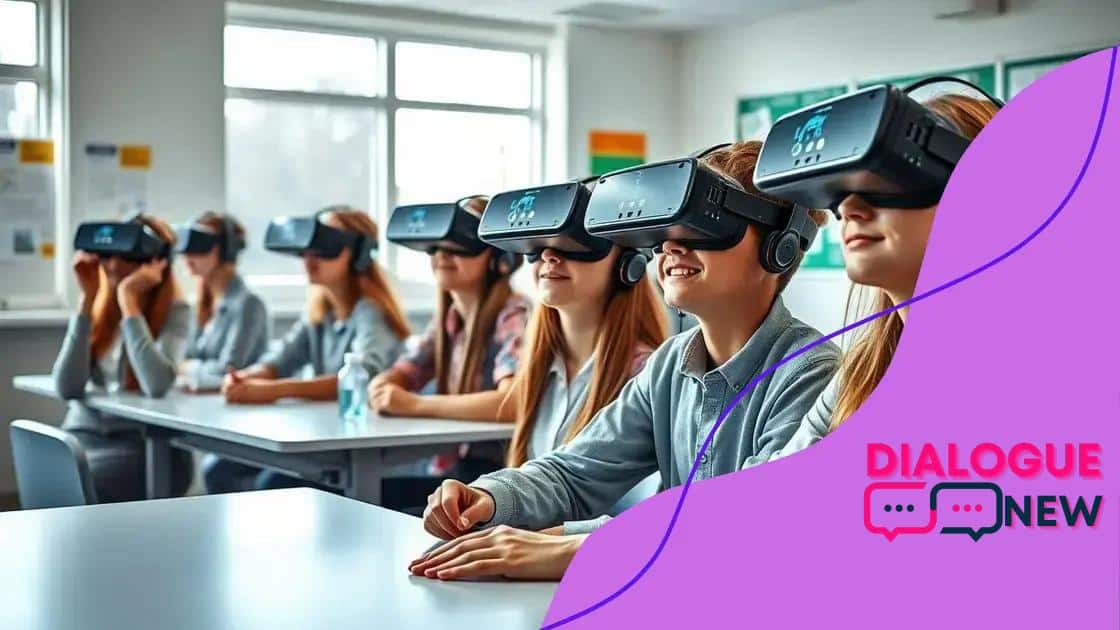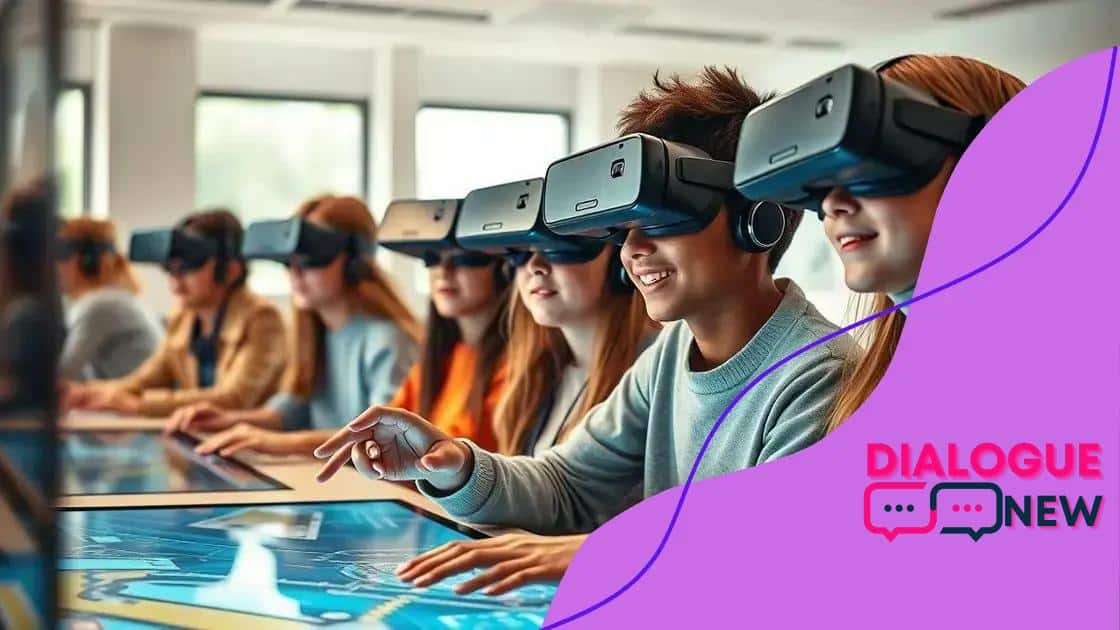Virtual reality in science education: a transformative tool

Virtual reality in science education enhances engagement and retention by providing immersive experiences, making complex concepts accessible and enabling personalized learning opportunities for students.
Virtual reality in science education is changing the way we learn and interact with complex concepts. Imagine stepping into a simulation where you can explore the human body or outer space. It’s this captivating experience that invites us to rethink what’s possible in classrooms today.
Understanding virtual reality in education
Understanding virtual reality in education can open up new possibilities for how students engage with learning materials. This innovative tool allows learners to immerse themselves in 3D environments tailored to educational content. By facilitating hands-on experiences, it can enhance understanding and retention of complex concepts.
What is Virtual Reality?
Virtual reality (VR) refers to a simulated experience that can be similar to or completely different from the real world. In an educational context, this technology can transport students to various environments, such as a rainforest, the surface of Mars, or a human cell. This not only provides visual stimulation but also allows for interactive learning.
How Does VR Enhance Learning?
The use of VR in education transforms passive learning into an engaging adventure. Here are some benefits:
- Increased Engagement: Students are more likely to participate actively.
- Experiential Learning: Learners experience scenarios that would be difficult or impossible to replicate in a classroom.
- Safe Environments: VR provides a safe space for trial and error, which is essential in learning.
With VR, students can conduct virtual experiments, explore historical sites, or even practice real-life skills without the risks associated with physical attempts. For instance, medical students can practice surgeries in a virtual operating room. This approach not only builds confidence but also paves the way for greater mastery of complex skills.
Another exciting aspect is its adaptability. VR technology can cater to various learning styles, making education more inclusive. Whether a student learns better by seeing, doing, or hearing, the interactive nature of VR can accommodate these preferences. Teachers can create tailored learning experiences that ensure every student can thrive.
Challenges in Implementing VR
Despite its advantages, integrating virtual reality into classrooms comes with challenges. Cost is a significant factor; the technology can be expensive, from hardware to software development. Additionally, there is a learning curve for educators to effectively implement VR in their teaching practices.
Moreover, schools may lack the necessary infrastructure to support this technology. To overcome these obstacles, it’s crucial for educational institutions to plan strategically and invest in training for teachers. With the right support, the power of VR can transform educational landscapes.
The impact of virtual reality on science learning
The impact of virtual reality on science learning has been profound, revolutionizing how educators present complex topics. With VR, students can experience phenomena like chemical reactions or astrophysical events first-hand, increasing their comprehension significantly. This hands-on approach enables learners to visualize concepts that are often abstract.
Enhanced Engagement
One of the most notable effects is enhanced engagement among students. When learners can step into a virtual universe or explore microscopic worlds, their motivation increases. Experiencing lessons in such a vivid way keeps their attention focused and boosts participation. Teachers report that students are more eager to learn when they interact with the material.)
Real-World Applications
Another key benefit is the insight into real-world applications. VR allows students to simulate real-life scenarios, such as conducting experiments or navigating ecosystems. This form of learning is impactful because it connects theoretical knowledge to practical experience. For example:
- Science labs: Students can perform experiments without the risk of accidents.
- Field trips: Virtual visits to distant locations enhance global awareness without leaving the classroom.
- Medical training: Future healthcare professionals can practice surgical techniques in a controlled setting.
Virtual reality also encourages collaboration among peers. Students often work in groups to solve problems or complete tasks within VR environments. This collaborative effort not only builds teamwork skills but also fosters a deeper grasp of scientific principles. They learn from each other while applying concepts in an immersive context.
Moreover, the adaptability of VR tools is impressive. They can be customized to meet the needs of diverse learners, including those who might struggle with traditional teaching methods. Visual learners benefit greatly from the interactive graphics, while kinesthetic learners thrive from the hands-on experiences VR offers. This inclusivity ensures that all students have the opportunity to succeed.
Challenges of VR Integration
While the benefits are clear, integrating virtual reality into the curriculum presents some challenges. Educators may need training to effectively utilize this technology. Additionally, not every school has access to the necessary hardware or software, which can create inequalities in educational opportunities. However, addressing these challenges is vital for fully realizing the potential that VR holds for science education.
Benefits of immersive experiences in teaching

The benefits of immersive experiences in teaching are substantial, especially when it comes to enhancing student learning. By utilizing technology such as virtual reality, educators can create environments that engage all the senses. This not only makes learning more interesting but also improves information retention.
Increased Engagement
One major benefit is increased engagement. When students are placed in a realistic setting, they become more active participants in their learning. Interactive lessons capture their attention, making them excited to explore. For instance, when studying ancient civilizations, students can walk through a virtual replica of a historic site. This captivates their imagination and encourages deeper inquiry.
Improved Retention of Knowledge
Research indicates that immersive experiences can significantly enhance knowledge retention. Students often remember what they experience more vividly than what they read or hear. By doing and seeing, information sticks better. Some ways this occurs include:
- Hands-on learning: Practicing skills in a virtual lab reinforces concepts more effectively than traditional methods.
- Visual storytelling: Engaging narratives help students connect emotionally, strengthening memory.
- Real-world simulations: Scenarios mimic real-life situations, allowing for practical application of knowledge.
This kind of experiential learning fosters critical thinking and problem-solving skills. As students interact with dynamic environments, they learn to apply concepts in various contexts. This process encourages creativity, as learners think outside the box to navigate challenges.
Another benefit is the ability to cater to different learning styles. Some students learn best through visual aids, while others benefit from hands-on activities. Immersive experiences allow for this customization, making education accessible to all. In this way, educators can support diverse learners, ensuring everyone has a chance to succeed.
Enhanced Collaboration and Communication
Immersive teaching also promotes collaboration among students. Many VR applications encourage group activities that require teamwork to solve problems. This social aspect builds communication skills as students must share ideas and work together to achieve goals. They learn the importance of collaboration, which is critical in today’s world.
Challenges and solutions in implementing VR
Implementing virtual reality in education carries several challenges, yet solutions exist to overcome them. Educators and institutions need to be aware of the hurdles to create an effective learning environment. By understanding these challenges, we can better utilize VR technology.
Cost of Technology
One significant challenge is the cost. VR equipment and software can be expensive for schools, especially those with limited budgets. Obtaining headsets, computers, and appropriate software requires substantial investment. However, schools can explore solutions like:
- Partnerships: Collaborating with tech companies for sponsorships or discounted rates.
- Grants: Seeking educational grants that support technology in classrooms.
- Used Equipment: Purchasing used or refurbished VR devices can reduce initial costs.
Overcoming the cost barrier allows for broader access to immersive learning experiences, impacting more students positively.
Training for Educators
Another challenge is the need for proper training. Not all teachers are familiar with VR technology, which can hinder its effective use. Educators may feel overwhelmed, limiting their comfort in integrating VR into the curriculum. To tackle this issue, schools can provide:
- Professional Development: Ongoing training sessions that focus on VR applications in education.
- Peer Learning: Creating opportunities for teachers to learn from each other’s experiences and successes.
- Online Resources: Offering access to tutorials and workshops that cover VR best practices.
This training builds confidence and competence among teachers, enabling them to use VR effectively to enrich student learning experiences.
Furthermore, there is also the challenge of technology compatibility and infrastructure. Not all schools have the necessary internet speeds or technical support to implement VR smoothly. Schools can consider solutions such as:
- Upgrading Infrastructure: Investing in faster internet connections and better hardware.
- Technical Support: Hiring IT staff or utilizing remote support to assist teachers and students.
By focusing on these solutions, schools can ensure the seamless implementation of VR into the classroom, enhancing educational experiences.
Future prospects of virtual reality in education
The future prospects of virtual reality in education are incredibly promising. As technology advances, we can expect to see more immersive and interactive learning environments. This evolution will not only enhance traditional teaching methods but may also transform the entire educational landscape.
Integration with Curriculum
One key area of growth is the integration of VR into existing curricula. Schools are beginning to experiment with incorporating virtual reality experiences in various subjects. Imagine studying history by virtually visiting ancient Rome or learning biology by exploring the human body from the inside. This integration can create a rich context for learning, allowing students to engage with subjects in a way that was not previously possible.
Accessibility and Affordability
As VR technology develops, it is becoming more accessible and affordable. Initially, VR headsets and software were costly and only available to a few. However, costs are expected to decrease as more companies enter the market. This trend will make VR tools available to a wider range of schools, promoting equity in education.
Future innovations may also include:
- Mobile VR: Using smartphones to create virtual experiences can make VR accessible for all students.
- Cloud-based VR: Storing content in the cloud allows for easier updates and sharing among schools.
- Subscription Services: Schools may subscribe to VR platforms that offer a range of educational content.
Such changes can democratize access to quality education resources and innovative learning experiences.
Personalized Learning
Another exciting prospect is the potential for personalized learning experiences. Virtual reality can tailor lessons and activities to meet individual student needs. By analyzing student interactions within VR, educators can adapt learning experiences based on the strengths and weaknesses of each student.
This personalized approach encourages mastery of subjects, allowing students to progress at their own pace and focus on areas they find challenging. As a result, learners may achieve better outcomes when their education is tailored to their personal learning styles.
Collaboration and Global Learning
Lastly, VR can facilitate collaboration among students globally. Virtual classrooms can connect learners from different countries, fostering cultural exchange and collaborative problem-solving. Imagine students working together on science projects while interacting virtually, regardless of their geographical location. This collaboration broadens perspectives and prepares students for a globalized workforce.
FAQ – Frequently Asked Questions about Virtual Reality in Education
How can virtual reality enhance student engagement?
Virtual reality provides immersive experiences that capture students’ attention, making learning more interactive and enjoyable.
What are the key challenges in implementing VR in schools?
Challenges include high costs, the need for teacher training, and ensuring technology compatibility with existing systems.
In what ways can VR personalize learning for students?
VR can adapt lessons to meet individual learning styles and paces, allowing students to focus on areas where they need more practice.
What future possibilities exist for virtual reality in education?
Future possibilities include wider accessibility, global collaboration between students, and further integration into various subject curricula.





